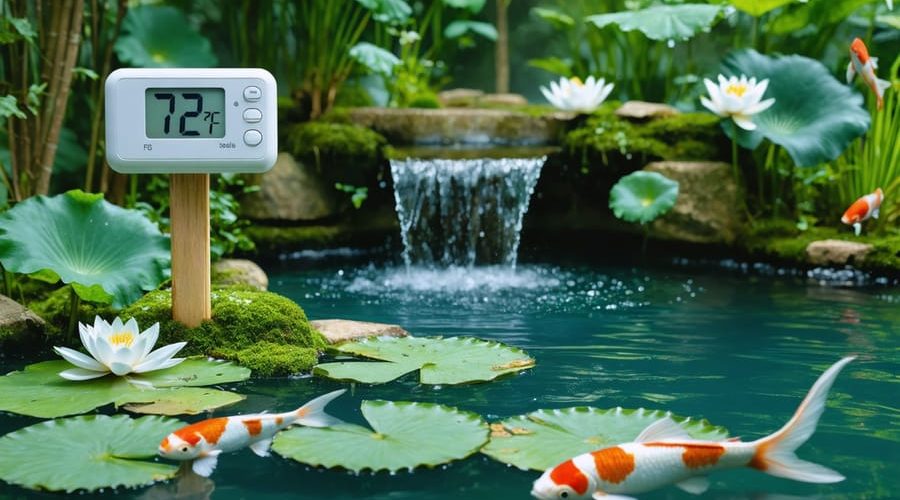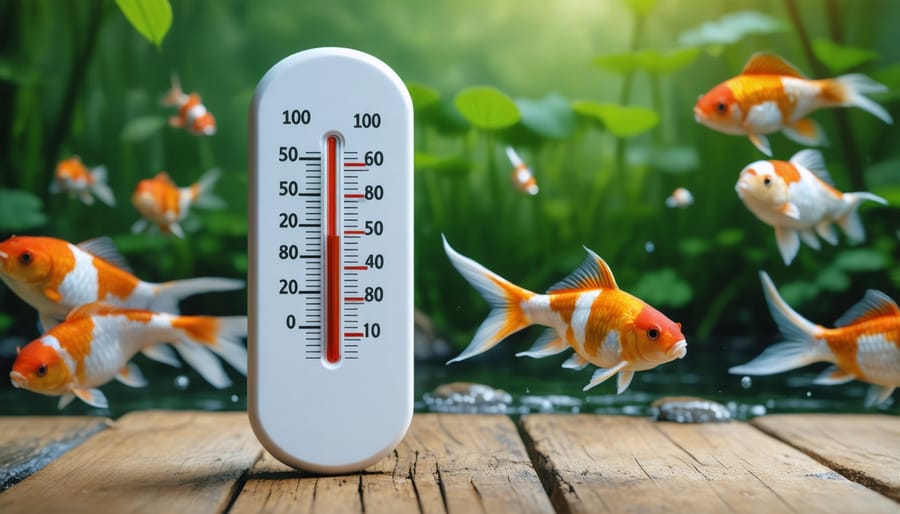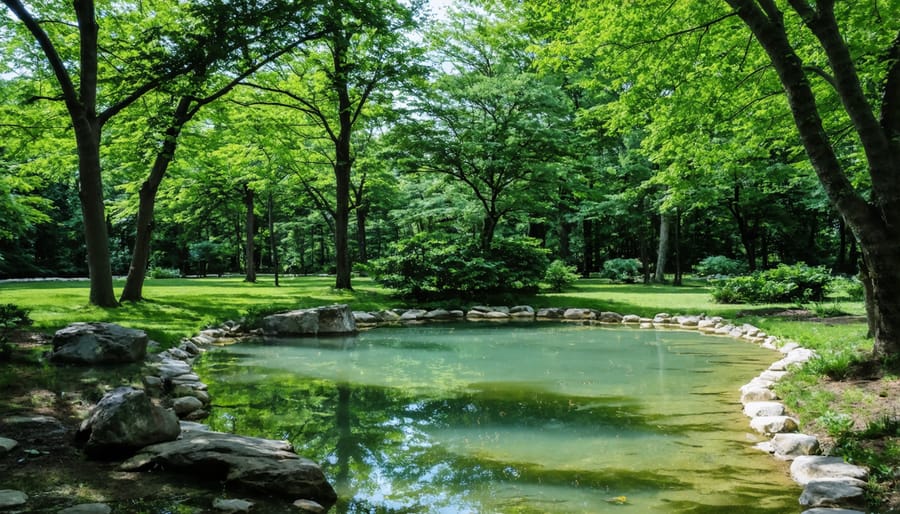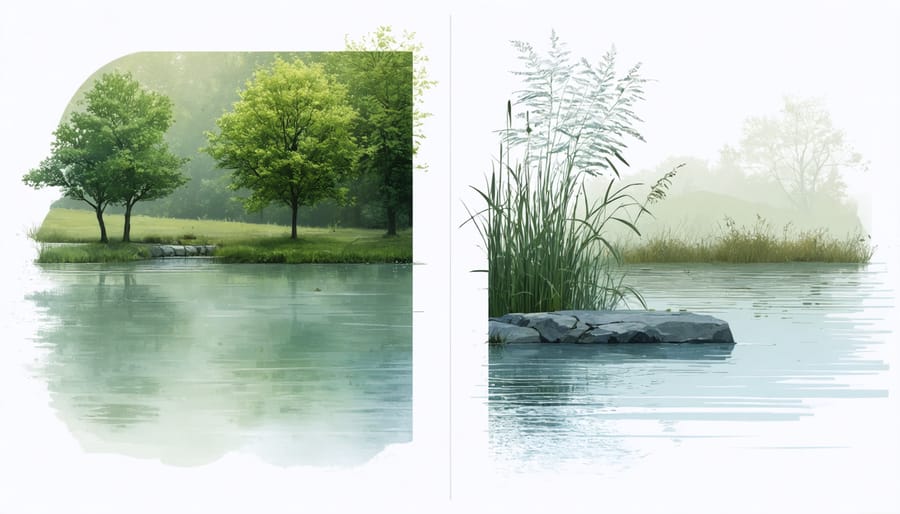
Keep Your Pond Temperature Perfect (Even During Heat Waves)
Stabilizing pond water temperature protects fish health and maintains ecosystem balance year-round. Following essential maintenance tips for your pond helps prevent sudden temperature swings that can stress aquatic life. Install a reliable pond thermometer to monitor daily fluctuations and respond quickly to changes. Create depth zones of at least 2-3 feet to provide temperature refuges during extreme weather, and strategically place floating plants to provide natural shade coverage of 40-60% of the water surface. Add a pond aerator or fountain to prevent temperature stratification while maintaining healthy oxygen levels throughout different water depths. During seasonal transitions, gradually adjust equipment settings and plant coverage to match changing environmental conditions, ensuring your pond remains a thriving habitat throughout the year.
Why Pond Temperature Matters
Ideal Temperature Ranges
Different pond inhabitants thrive in specific temperature ranges, and understanding these requirements is key to maintaining a healthy ecosystem. Most koi and goldfish prefer water temperatures between 59-77°F (15-25°C), with koi being slightly more tolerant of temperature variations. However, they become stressed when temperatures rise above 85°F (29°C) or drop below 50°F (10°C).
Water lilies and lotus plants generally flourish in temperatures between 65-85°F (18-29°C). Marginal plants like cattails and iris are more adaptable but prefer similar ranges. Tropical water plants need warmer temperatures, typically above 70°F (21°C), and should be brought indoors during colder months.
Beneficial bacteria, essential for pond health, are most active between 55-85°F (13-29°C). Their activity significantly slows below 50°F (10°C), which affects the pond’s natural filtration process. When temperatures approach these limits, it’s crucial to monitor your pond more closely and take appropriate action to protect your aquatic life.
Remember that sudden temperature changes are more harmful than gradual ones, so aim to maintain stable temperatures within these ranges whenever possible.

Warning Signs of Temperature Problems
Keeping an eye on your fish and plants can help you spot temperature-related problems before they become serious. Fish in distress often swim erratically or gasp at the surface, especially during hot summer days. You might notice them clustering near deeper areas or around fountains where the water is cooler and more oxygenated.
Watch for fish that appear lethargic or lose interest in feeding – these are classic signs of temperature stress. During cold snaps, fish may become extremely sluggish or hover near the bottom of the pond. For pond plants, yellowing leaves, wilting, or unusual growth patterns can indicate temperature issues.
Other warning signs include rapid algae growth during warm periods or ice formation during winter that could trap harmful gases. If you notice your fish staying in one particular area of the pond all the time, this might mean they’re seeking out a more comfortable temperature zone.
Pay special attention during sudden weather changes, as these rapid temperature shifts can be particularly stressful for pond life. Quick action when you spot these signs can prevent more serious problems from developing.
Natural Temperature Control Methods
Strategic Pond Depth
A critical aspect of successful garden pond design is getting the depth right. A deeper pond naturally maintains more stable water temperatures throughout the year. The ideal depth for temperature stability is typically between 4 to 6 feet, which creates a thermal mass that resists rapid temperature changes.
Think of your pond’s depth as a natural thermos – the more water it holds, the more it buffers against external temperature fluctuations. This is especially important for fish health, as sudden temperature changes can stress or harm them. During summer, the deeper water remains cooler, providing fish with a retreat from surface heat. In winter, deeper areas are less likely to freeze completely, protecting your aquatic life.
When planning your pond depth, consider creating different zones. Include shallow shelves (1-2 feet) for plants and deeper areas for temperature stability. This variety not only helps with temperature management but also creates a more natural ecosystem. Remember that local climate should influence your depth decisions – warmer regions might benefit from slightly deeper ponds to maintain cooler temperatures.

Shade Solutions
Natural shade solutions offer an eco-friendly and aesthetically pleasing way to regulate your pond’s temperature. When planning your backyard pond ideas, consider incorporating strategically placed trees and shrubs around the northern and western edges of your pond. These not only provide essential shade during the hottest parts of the day but also create a more natural-looking environment.
Water lilies and floating plants like water hyacinth are excellent options for direct water surface coverage. These plants naturally regulate temperature by blocking intense sunlight and reducing water evaporation. Aim to cover about 50-60% of your pond’s surface with floating vegetation for optimal temperature control while still allowing enough light for underwater plants to thrive.
Marginal plants along the pond’s edges can provide additional shade while creating beautiful transitions between your pond and surrounding landscape. Consider plants like iris, rushes, and sedges, which offer shade without being too invasive. These plants also help filter the water and provide shelter for pond wildlife.
For temporary shade solutions, you might want to install shade sails or floating pond covers during extreme heat waves. These can be particularly useful if your pond is newly established and waiting for plants to mature. Remember to position any artificial shade structures so they can be easily adjusted or removed as seasons change, allowing more sunlight during cooler months when it’s beneficial for your pond ecosystem.
Equipment and Technologies
Pond Aerators and Fountains
Water movement plays a crucial role in maintaining stable pond temperatures, and that’s where aerators and fountains come in handy. These features do more than just create beautiful water displays – they’re essential tools for temperature regulation in your pond ecosystem.
Fountains and aerators work by constantly moving water through the air, which helps prevent temperature stratification. This means the water stays more consistently mixed, avoiding hot spots near the surface and cold pockets at the bottom. When combined with a proper filtration system, these features create a healthier environment for your fish and plants.
During hot summer days, the movement created by aerators helps cool the water through evaporation. As water droplets spray through the air, they release heat and return to the pond slightly cooler. In winter, keeping water moving can help prevent complete freezing, especially in areas where temperatures drop below freezing.
For best results, consider running your fountain or aerator 24/7 during extreme temperature periods. You can adjust the spray height seasonally – higher in summer for maximum cooling effect and lower in winter to minimize heat loss. Remember that different pond sizes may require different sized aerators, so it’s worth consulting with a pond specialist to find the right fit for your water garden.
Heating and Cooling Systems
When natural methods aren’t enough to maintain ideal pond temperatures, mechanical heating and cooling systems can be real lifesavers for your aquatic friends. For winter protection, submersible pond heaters are a popular choice, ranging from basic 100-watt models for small ponds to powerful 1500-watt units for larger water features. These heaters help maintain a small ice-free area, allowing for essential gas exchange.
If you’re dealing with particularly harsh winters, consider installing a floating de-icer. These units float on the surface and prevent ice formation in a specific area, which is usually all you need to keep your pond healthy during cold months. For year-round temperature control, an in-line heater connected to your pond’s plumbing system offers precise temperature management.
During hot summer months, cooling systems become essential in many regions. Pond chillers work like reverse heaters, cooling the water as it passes through them. While they’re effective, they can be expensive to run. A more budget-friendly option is an aerator or fountain, which not only helps cool the water through agitation but also improves oxygen levels.
For the tech-savvy pond owner, modern temperature control systems come with digital controllers and smartphone connectivity, allowing you to monitor and adjust your pond’s temperature remotely. Whatever system you choose, remember to properly size it for your pond’s volume and consider your local climate conditions.

Seasonal Temperature Management
Summer Heat Management
During those scorching summer months, keeping your pond from overheating is crucial for the health of your fish and plants. One of the most effective ways to manage summer heat is by providing adequate shade. Consider adding floating plants like water lilies, which not only look beautiful but also create natural cooling shadows on the water surface.
Installing a fountain or waterfall helps in two ways: it creates water movement that promotes oxygen circulation and helps cool the water through evaporation. If you’re noticing consistently high temperatures, running your fountain during the hottest parts of the day can make a real difference.
Deep areas in your pond (at least 2-3 feet) act as natural cooling zones where fish can retreat when surface waters get too warm. If your pond is shallow, consider adding depth during your next maintenance overhaul.
Keep an eye on your water levels during summer, as evaporation increases in hot weather. Top up when necessary, but remember to use dechlorinated water to protect your pond life. Adding fresh water in the morning gives it time to adjust to the pond’s temperature naturally.
For emergency cooling, you can float sealed bottles of frozen water on the surface, but use this method sparingly as sudden temperature changes can stress your fish. Regular monitoring with a pond thermometer helps you spot potential problems before they become serious.
Winter Temperature Protection
Winter can be particularly challenging for pond owners, but with the right precautions, you can keep your pond water from freezing and protect your aquatic friends. The most important thing is to prevent the pond from freezing completely over, as this can trap harmful gases and endanger your fish.
A floating de-icer is one of the most effective tools for winter protection. Place it in your pond before temperatures drop below freezing to maintain a small ice-free area. This opening allows for crucial gas exchange and helps prevent toxic buildup under the ice.
Adding a pond netting about 18 inches above the water surface creates an air pocket that helps insulate the water. This simple solution also catches falling leaves and debris that could affect water quality. For extra protection, consider installing a small air pump near the surface – the bubbles will help keep a section from freezing while adding beneficial oxygen.
Never break ice that forms on your pond by hitting it, as the shock waves can harm your fish. Instead, use a pot of hot water to melt a hole if needed. It’s also wise to avoid removing snow from the pond surface unless it’s very heavy, as snow actually acts as an insulator.
If you have a waterfall, you might want to shut it down during extreme cold to prevent ice formation and potential damage to your pump. Remember, fish will naturally slow down and require less food during winter, so minimal disruption is often best.
Maintaining proper pond water temperature is crucial for the health and vitality of your aquatic ecosystem. Throughout this guide, we’ve explored various methods to help you keep your pond temperature stable, from using natural shade and aquatic plants to implementing technological solutions like pond heaters and aerators. Remember that different seasons bring unique challenges, making regular temperature monitoring essential year-round.
By implementing a combination of these strategies and staying vigilant with your temperature checks, you can create a thriving environment for your fish and plants. Don’t forget to conduct daily temperature readings, especially during extreme weather conditions or seasonal transitions. Small adjustments made consistently can prevent major temperature fluctuations that could stress your pond inhabitants.
Whether you’re a seasoned pond keeper or just starting, the key to success lies in understanding your pond’s specific needs and responding promptly to temperature changes. With proper maintenance and regular monitoring, you’ll be rewarded with a beautiful, healthy pond that brings joy throughout the year. Keep these tips in mind, and don’t hesitate to adjust your approach as you learn what works best for your unique water garden.
